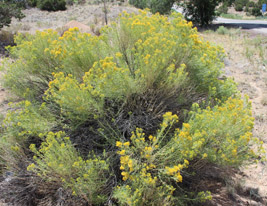Food:
"The milky sap (latex) of these shrubs contains rubbery compounds. The bark of the lower stem and roots of several species of rabbitbush was widely used as chewing gum." (Kershaw 88)
"The record we have of rabbitbush as food comes from San Felipe Pueblo, where the flower buds once were eaten." (Dunmire and Tierney 149)
"In spite of its pungent chemistry, he Navajo cooked the green leaves together with wild onions in meat dishes. The seeds were added to cornmeal porridge and bread." (Finley and Nieland 52)
"(Kawaiisu) Sharpened twig, stripped of bark and leaves, threaded with pinyon nuts to improve their flavor. (Paiute, Northern) Root bark chewed like gum" (Moerman 160)
Medicine:
"The Navajo used rabbitbrush leaf tea to bring down fever, treat smallpox, and relieve arthritis pain. The flowers and roots were used to make a tea to relieve tuberculosis. In the ob-gyn department, the Navajo made and an anodyne for menstrual pain from the roots. Other tribes used rabbitbrush to make a sanitary napkin to promote healing after childbirth." (Finley and Nieland 52)
"The roots of common rabbitbush were boiled to make a strong decoction for treating coughs, fevers, colds and old internal injuries and for easing menstrual cramps. To relieve headaches, the leaves were used to make a medicinal tea that was applied as a lotion. The leaf tea was also taken internally to reduce fevers and relieve constipation, colds and stomach problems. Mashed rabbitbush leaves were packed into decayed teeth to relieve toothaches." (Kershaw 88)
"A tea made by steeping the leaves seems to have worked for curing stomach disorders at several pueblos. This tea was also used as a gargle for colds at Jemez and as a bath for fever patients at Isleta; at Sandia ground dry leaves mixed with cornmeal were used in treating wounds.
Certain insects like to deposit their eggs on the twigs and stems of this plant, causing galls a half-inch in diameter to form. A liquid mixture of ground rabbitbrush galls was once employed at Cochiti to relieve toothaches and at Santa Clara for stomach problems." (Dunmire and Tierney 149)
"A tea made from the plant is used as a febrifuge and, finally, its white galls, resulting from the sting of a dipterous insect, are strung as beads and hung around babies' necks. This practice is supposed to stop their drooling." (Curtin 43)
"Some rabbitbrush plants are decorated with little cotton balls along the stems. These are actually galls made by small flies in the Tephritidae family. Chemicals from the developing larvae trigger the formation of tumorlike tissue that encases the pink larvae. Indian tribes used the cottony galls to treat toothache and stomach problems." (Finley and Nieland 52)
Recipe: Rabbitbush and Artemisia Soak
"Ritual bathing and aromatic soaks are wonderful things to cultivate in our hectic modern lives. The American understanding of aromatherapy has become confused as factory-produced chemical scents are increasingly sold as aromatherapy develop your understanding of real aromatherapy, and of bathing rituals that help your body and mind feel nourished and able to succeed, using real plants.
Harvest several branches of rabitbrush with fresh yellow flowers. Also harvest several stalks of one of the artemisia varieties. You can use big sagebrush or a less-woody variety like fringed or white sage. Place several boughs of each into the bathtub, and fill with hot water. Keep the bathroom door closed while the tub is filling to retain the aromatherapy. Turn the lights down low, and sink into your very own desert-scented spa. As you soak you can use the boughs to gently scrub and exfoliate your skin." (Morgan 192)
Other Uses:
"The branches of rabbitbush were burned slowly to smoke hides. The leafy boughs were used to cover sweathouses and to carpet the floor. Mature flowers were boiled for at least 6 hours to produce a lemon-yellow dye. Alum was then added as a mordant, along with the wool or leather to be dyed, and boiling continued for about an hour. When dying baskets, the flowers and buds were boiled overnight and the basket material was then soaked in the dye for about 12 hours. No mordant was used. Immature buds or twigs gave the dye a greenish tinge." (Kershaw 88-9)
"The making of arrows or arrowheads from mature rabbitbrush limbs has been reported at Acoma, Laguna, and Isleta pueblos, but this certainly was not the preferred wood for arrow parts throughout the Pueblo Province." (Dunmire and Tierney 149)
"Rabbitbrush is an eco-friendly chemical manufacturing facility. It contains about 7 percent rubber by dry weight and was tested as a source of rubber during World War II. It also contains about 35 percent resin by dry weight in the leaves and trichomes (hairlike glandular structures). This resin contains aromatic terpenoid compounds that may be useful for the manufacture of varnishlike plastics. Some of the terpenoid compounds have been tested as nematicides and insecticides." (Finley and Nieland 51-2)
"One of rabbitbrush's most important uses is as a dye for coloring wool, cotton, and baskets. Several tribes use the plant to produce a colorful palette of yellow and green dyes-yellow from the mature flowers and green from the immature flowers, leaves, and green bark.
In the past, Native Americans used rabbitbrush for an eclectic assortment of other life needs. The Hopi used it to weave a belt for weddings, made arrows from the wood, and made windbreaks with the bushes."(Finley and Nieland 52)
"(Hopi) Plant used to weave the wedding belt. Plant used on the Po-wa-mu altar and used in Cauol ceremony. Stems used to make wicker plaques. Stems used to make arrows. (Paiute) Peeled stems used for piercing ears in preparation for wearing earrings." (Moerman 160)
Special Note
In the spring round galls may be found on the chamisa stems. These are the result of larva of the the Picture-Winged Fly (Aciurina bigeloviae). Also, there may be a dark metallic blue-green colored larva of the Chamisa Leaf Beatle seen on the leaves. (The LA Daily Post)
